Imagine entering a store where every employee knows your name, remembers what you like, and makes you feel at home. Sounds cool, right? Well, that’s what customer engagement technology is doing for online businesses. It’s magic, turning regular shopping into a personalized, fun experience. Have you ever wondered how some companies nail it so well that you feel like they’re reading your mind? Let’s dive into that and see ways you can use technology to improve customer engagement.
Key Points
- Customer engagement technology uses digital tools to enhance the connection between businesses and their customers. These tools facilitate meaningful interactions, making the customer experience more personalized and satisfying and strengthening customer loyalty.
- A solid customer engagement strategy is essential, regardless of a product’s market position. With 2.64 billion people shopping online, building trust and providing a seamless experience is crucial for retaining customers, as 30% of people will abandon a brand after just one bad experience.
- To use technology effectively for customer engagement, businesses should understand their audience, choose the right communication channels, create value and trust, maintain ethical standards, encourage feedback and interaction, and continuously innovate.
- Top-notch customer engagement platforms to help you implement our proposed technology: Userpilot, Hotjar, Drift, and HubSpot
- The four “P”s of Customer Engagement include Proactive, Personalized, Person (Human) based, and Problem-Solving.
Customer Engagement Technology
Customer engagement technology uses digital tools to help businesses connect better with their customers. It’s like having a secret weapon to build stronger relationships by keeping customers actively involved for the long haul.
But how does it work?
These tools let businesses listen to their customers and respond in meaningful ways. They make the customer’s experience more personal and satisfying. Here are a few examples:
- Intercom: Real-time engagement with chatbots and live chat.
- Gleam: Boosts participation with interactive contests and rewards.
- Qualtrics: Enhances experience through feedback collection and analysis.
- LeadsHook: Engages prospects with personalized marketing funnels and quizzes.
In short, these tools help businesses stay connected with their customers, understand their needs, and provide quick solutions. They add value to every interaction, which boosts customer loyalty to your brand.
You might think, “If my product is already No. 1 in the industry, do I still need this tech?” The answer is a big YES. Even the best products or services need a solid customer engagement strategy. Why? Because 2.64 billion people shop online, about 1 in 3 people. And when people shop online, connecting with them is tough.
Here’s why:
- If you sell a physical product, online shoppers can’t touch or experience it in person.
- If you offer a service or digital product, they rely on reviews more than your product description.
- People are wary of scams, fraud, or misinformation, making trust-building harder.
- They have easy access to competitors and low attention spans.
Even if customers like your product or trust you because you’re No. 1, they won’t stick around if their experience sucks. According to PwC, 3 out of 10 people will ditch a brand they love after just one bad experience.
Customer engagement tools can’t solve all these problems, but they greatly help. They make sure your buyer feels supported throughout their journey with your brand. These tools improve interactions at every stage of the buying process, keeping your customers happy and loyal.
Read How Digital Technology Revolutionized My TV Viewing Experience
How to Use Technology to Engage Customers?
I remember my first encounter with such technology vividly. I was shopping for a new laptop online and found myself on a site that anticipated my every need. A friendly chatbot popped up, asking if I needed help, and it wasn’t just a generic message it suggested models based on the specifications I had been browsing. The chatbot even offered a comparison feature, allowing me to weigh my options easily. It felt less like an interaction with a machine and more like a conversation with a knowledgeable friend. This level of engagement kept me on the site longer, made my decision-making process more accessible, and ultimately led to a purchase I felt confident about.
So, what exactly goes into creating such an engaging customer experience? How do companies leverage these technologies to foster loyalty and satisfaction?
Let’s break it down.
Technology is an excellent tool for connecting with customers and building long-term relationships. But how do you use it effectively and responsibly without compromising your values or customers’ privacy? Here are some tips and best practices to help you use technology to engage with your customers in a way that’s ethical, respectful, and beneficial for both sides. See infographics below:

#1. Know your Audience
Before you use any tech to communicate with your customers, you must understand who they are, what they need, and how they prefer to interact with you. Gather data through surveys, feedback forms, analytics, or social media. But remember, respect their privacy. Don’t collect or use irrelevant, sensitive, or invasive data. Always inform your customers how you use their data and give them options to opt in, out, or delete their data.
#2. Choose the Proper Channels
Once you know your audience, pick the best channels to reach them. Depending on your goals, budget, and customer preferences, you can use email, SMS, chatbots, video calls, webinars, podcasts, blogs, social media, or apps. Make sure your communication is consistent, relevant, and engaging. Monitor and measure the effectiveness of your channels and adjust as needed.
#3. Create Value and Trust
The goal is to create value and trust with your customers. Offer solutions to their problems, meet or exceed their expectations, and show that you care. Use technology to provide helpful information, discounts, or rewards, ask for feedback, share testimonials, or show social proof. Personalize your communication by addressing customers by name, preference, or behavior.
#4. Be Ethical and Responsible
Using technology to engage customers comes with responsibilities. Be ethical and avoid practices that are dishonest, deceptive, or harmful. Protect your customers’ data from risks like cyberattacks, data breaches, or identity theft. Follow laws and regulations regarding data protection and privacy. Be transparent and accountable for your actions, and correct any mistakes.
#5. Encourage Feedback and Interaction
Encouraging feedback and interaction helps you improve your products or services, understand your customers better, and build loyalty. Use technology to invite questions, comments, or reviews, create polls or quizzes, host live events or Q&A sessions, or join online communities. Respond to feedback promptly, politely, and professionally, and show appreciation and recognition.
#6. Keep Learning and Innovating
Engaging with customers using technology is an ongoing process. Keep up with the latest trends and technological developments, and explore new ways to enhance customer engagement. Learn from your customers’ feedback and interaction to innovate your products or services or create new ones.
Are you ready to take your customer engagement to the next level? We’re excited to introduce our Customer Engagement Strategy Checklist, a comprehensive guide designed to help you connect with your audience like never before.
Using technology effectively can transform customer engagement, creating meaningful and lasting relationships. So, how do you use technology to connect with your customers? Let’s chat about it!
15 Ways to Use Technology to Improve Customer Engagement
There are countless ways to leverage technology to boost customer engagement:
#1. Artificial Intelligence
Real-time responses are crucial for successful customer engagement. Instant answers save time and reduce frustration, which is often a common issue when dealing with support teams. With AI, handling customer interactions becomes much more efficient. Businesses that harness A.I. effectively are poised to lead in customer support. Chatbots, a prime example of AI, can automate service delivery and significantly enhance customer experiences. Integrating chatbots with human support can elevate engagement levels tremendously.
Tips for Using A.I. to Improve Customer Engagement:
- Automate tasks across support channels to ensure customers receive prompt help throughout their journey.
- Combine A.I. with human resources to deliver personalized engagement that customers expect.
#2. In-App Messaging
In-app messaging has become indispensable in SaaS, transforming customer interactions. Previously, with in-app communication, customers had to rely on onboarding information or seek external help when they needed clarification. In-app messaging allows for real-time, contextual communication, improving onboarding and overall customer satisfaction. Tools like Userpilot enhance this by allowing communication based on in-app behavior, increasing messaging efficiency without requiring any coding.
#3. Speech Recognition
Voice-activated communication is fast and convenient, making it a valuable customer engagement tool. Popularized by devices like Alexa, Siri, and Google Assistant, speech recognition is increasingly used for business purposes. Integrating this technology into your product can improve user experience, as it’s already familiar to many customers.
#4. Social Listening
Social listening tracks conversations about your brand across social media. These tools now provide analytics to measure brand perception and allow real-time customer interaction. Engaging with customers during these conversations helps address concerns and show appreciation, enhancing the overall customer experience.
#5. Sentiment Analysis
There needs to be more than just tracking online mentions; understanding the sentiment behind these conversations is critical. While manual analysis is possible, it’s time-consuming. Sentiment analysis technology, like Userpilot, can collect feedback through surveys and provide an instant overview of user sentiment, making it easier to gauge customer emotions at scale.
#6. Facial Recognition
Facial recognition extends beyond unlocking devices. Brands use this technology to entertain users, improve experiences, and boost retention. Examples include branded filters on Instagram and Snapchat, which generate excitement and engagement around the brand.
#7. A.R. and V.R.
Augmented reality (A.R.) and virtual reality (V.R.) offer immersive and personalized experiences. A.R. blends the physical world with digital elements, while V.R. is entirely digital. Technologies like Smart Glasses and Facebook’s Metaverse have popularized these experiences, making them valuable for keeping customers engaged and enhancing learning and digital interactions.
#8. Omnichannel Systems
Customers today expect seamless, interconnected experiences across multiple channels. Omnichannel systems help manage these interactions effectively, reducing communication friction and improving customer relationship management.
#9. Ask for Customer Feedback
Understanding customer needs and preferences is essential for creating personalized content. Soliciting feedback provides valuable insights into customer likes, dislikes, and desires. Tools like Storyly’s Question Sticker make gathering feedback easy and create content that resonates with your audience.
#10. Ensuring an Active Social Media Presence
An active social media presence is crucial for engaging with customers. Develop a clear strategy, post consistently, and engage with your followers. Leveraging user-generated content can boost engagement and build a community around your brand.
#11. Use Interactive Elements like Polls and Quizzes
Interactive elements like polls and quizzes capture attention and encourage active participation. They provide insights into customer preferences and create an enjoyable experience, fostering deeper connections and brand loyalty.
#12. Use Shoppable Videos and Posts
Shoppable videos and posts integrate shopping experiences into your content, making it easy for customers to purchase directly. This reduces friction in the buying process and enhances the user experience, driving higher conversion rates.
#13. Implement Gamification Strategies
Gamification uses game-like elements to motivate and engage users. Points, badges, leaderboards, and challenges encourage frequent interaction and investment in your platform, driving higher engagement and loyalty.
#14. Send Targeted Email Campaigns
Targeted email campaigns deliver personalized messages to specific audience segments, increasing engagement and conversions. Personalized recommendations, special promotions, and exclusive content tailored to recipients’ interests ensure your emails are valuable and not intrusive.
#15. Utilize Push Notifications
Push notifications provide timely updates and alerts, keeping your brand in mind. They can inform customers about new products, special offers, and personalized recommendations, driving user engagement and increasing conversion rates.
What Are the 4 PS of Customer Engagement?
Just like the four “P”s of marketing, here are the four “P”s of customer engagement: Proactive, Personalized, Person (Human) based, and Problem-Solving.
#1. Proactive
Instead of waiting for customers to reach out, anticipate their needs and initiate the conversation. For example, if an airline passenger loses their bag, don’t wait for them to call and complain. Reach out first to apologize and address their frustration.
#2. Personalized
Today’s digital marketing landscape demands personalization at an individual level. Messaging needs to be tailored to each customer; sending the same generic email to thousands of people just doesn’t cut it anymore.
#3. Person (Human) Based
While AI and automation are revolutionizing customer engagement, doing just what is necessary is crucial. Chatbots and virtual assistants are great, but too much automation can backfire. Empathy is critical in customer interactions. The best approach combines automation for routine tasks with human agents and A.I. support to provide exceptional service.
#4. Problem-Solving
When dealing with customers, especially those who’ve had a bad experience, focus on solving their problems rather than just offering repeated apologies. Provide solutions and options to address their issues effectively.
What Are the 6 Key Elements of Customer Engagement?
- Reliability
- Availability
- Simplicity
- Adaptation
- Anticipation
- Accountability
Best Customer Engagement Tools
In this section, we’ll explore some top-notch customer engagement platforms to help you implement our proposed technologies. Let’s dive in.
#1. Userpilot

Userpilot is an all-in-one solution designed to boost customer engagement at every touchpoint. How users start their journey with your product often determines how long they stay, and that’s where Userpilot excels.
With Userpilot, you can access various U.I. elements and patterns to create the best user onboarding flows.
Userpilot ensures users are engaged through contextual and timely in-app messages, helping them navigate the app seamlessly and stay informed with important announcements.
But that’s not all. Userpilot also offers:
- Feedback Collection and Analysis: Track user sentiment with ease using in-app microsurveys.
- Product Analytics: Segment users to analyze behavior, create personalized experiences, conduct feature experiments, and identify reasons for churn.
#2. Hotjar

Hotjar combines session analysis and feedback to provide deeper insights into customer behavior.
You can see how users interact with your product using Heatmap and Session Recording features. This helps you quickly identify friction points and optimize the user experience.
#3. Drift

Drift focuses on improving business-customer relationships through various communication tools. From emails to video conversations and chatbots, Drift provides a suite of tools for efficient communication.
The intuitive dashboard makes it easy for teams to switch between communication channels. Drift integrates seamlessly with tools like Salesforce, Zapier, Zendesk, and Slack.
#4. HubSpot

HubSpot is a comprehensive CRM platform offering various tools for sales and marketing teams. Create and track emails, build online forms and landing pages, and automate customer support with HubSpot’s chatbot builder.
Ready to revolutionize your tech projects? Download the Technology Implementation Plan Template now and take the first step towards seamless integration and enhanced productivity
Conclusion
Customer engagement is crucial for retention and loyalty, especially in competitive markets where users can easily switch brands when dissatisfied. As we’ve seen, technology allows you to engage customers at scale, personalizing each experience as a one-on-one interaction. The right tools will leave your customers more satisfied and motivated to stay with your brand longer.
Related Post
Understanding Your Customers: Advanced Techniques in Audience Analysis
Customer Marketing: 8 Killer Customer Marketing Strategies for Building Your Brand
10 Communication Best Practices You Should Know to Improve Employee Engagement






